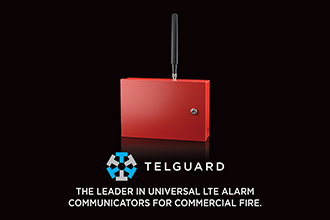Let’s face it — traditional POTS lines are a thing of the past — but many are still reliant on this communication to service their fire panels. How can you drop the landline and transfer the recurring revenue from the carrier to your company — and stay in good graces with your Authority Having Jurisdiction (or AHJ)? AHJs have the power to approve or reject your next commercial fire project, and it’s your responsibility to know and demonstrate how the cellular sole path solution you’re proposing meets their requirements, regardless of which version of NFPA 72 the AHJ is working from.
Let’s face it — traditional POTS lines are a thing of the past — but many are still reliant on this communication to service their fire panels. How can you drop the landline and transfer the recurring revenue from the carrier to your company — and stay in good graces with your Authority Having Jurisdiction (or AHJ)?
AHJs have the power to approve or reject your next commercial fire project, and it’s your responsibility to know and demonstrate how the cellular sole path solution you’re proposing meets their requirements, regardless of which version of NFPA 72 the AHJ is working from. AHJs across the country work from versions that are not necessarily the most current available. It’s important for you to make sure you know which version of NFPA 72 the AHJ is working from before you present.
As National Fire Prevention Month draws to a close, we recently caught up with experts from Telguard on working with AHJs regarding reliable, robust, cost-effective communication pathways on commercial fire jobs.
Onder Aksoy is a Firmware Engineer at Telguard and is actively involved with the Telguard TG-7FS LTE Cellular Communicator for Commercial Fire from an engineering standpoint. There are tens of thousands of TG-7FS units deployed across the U.S.
John Malstrom is the Telguard Regional Sales Manager for the North Central U.S. whose coverage area includes the state of Kentucky, which you’ll read about later. John’s many years of experience working with AHJs and security dealers across his region provides real-world insights when it comes to understanding the benefits of using cellular communicators.
If your AHJ hasn’t approved anything but the traditional multiple landline communicator, is proposing to use a universal cellular communicator is a waste of time?
TELGUARD: The AHJ should not be viewed as your solution provider, nor should he/she be viewed as an adversary – understanding the NFPA requirements and being able to demonstrate you do is your responsibility, not the AHJ's. Get to know your AHJ, the AHJ is your ally. Understanding the needs of the site installation and how the Telguard communicator meets the needs will go a long way towards building a trusting relationship.
AHJs may enforce requirements based on previous approvals, so it may be of benefit to research buildings in the area and indicate existing use of sole path communicators such as the Telguard TG-7FS. The AHJ will decide based on the data in the proposal you submit, so anticipate the AHJ's questions and present facts for them to consider and approve your proposal. Be upfront and respond promptly; putting in the effort will demonstrate that you are a resource.
TELGUARD: AHJs certainly rule, there’s no doubt about it. However, I would counter it’s never a “waste of time” to apply to a AHJ with no history of approving cellular. In my work with dealers/AHJs, the real issue is not that they will “never” approve, but that they want to feel comfortable/confident that the sole path solution meets their requirements. Most folks have had issues with cell phones, personally with the infamous “dropped call.” Several AHJs simply assume you want to stick a “cell phone” between the fire panel and the monitoring center.
When we (Telguard partnered with a dealer/installer) get a chance to educate the AHJ on the supervisory nature of the sole path application, the vast majority of them do wind up approving — even if they were not a fan at first. This also allows a great opportunity for that dealer to take the role as a “technology consultant” with the AHJ, being able to keep him or her up to date on changing technology as it develops, and that’s always good for business.
Should budget even be a piece of the discussion?
TELGUARD: Money talks. The cost efficiency of cellular versus POTS lines for the customer is an additional incentive for dealers to propose sole path communicators. Besides, AHJs are very local — they most likely know the business owner (and the dealer) on a personal level.
How would a dealer/integrator communicate that it’s a superior communication channel?
TELGUARD: The bottom line is sole path solutions make the building safer. With traditional two independent POTS line panels, they are on a once-a-day test. The Achilles heel of this situation has always been, “What if a storm knocks out the phone lines right after the test?” Worst case scenario is that 24 hours go by before anyone is aware of any problem on site.
This was the exact reason KY State Parks decided to use Telguard sole path communications in the resort locations in KY State Park, for example. With a five or 60-minute supervisory signal, no more than 5 or 60 minutes can go by without the central station being aware of any problems with the site. You take a worst-case scenario of 24 hours and reduce it to either 5 or 60 minutes — and that’s hard for an AHJ to say no to.
Do you believe we’ll see a domino effect, where the hard work of some pay dividends for all when it comes to approvals?
TELGUARD: Developing a good relationship with the AHJ will pay dividends. AHJs talk among themselves as well as other municipality officials, so your reputation as a knowledgeable resource will provide the credibility to make approvals easier for the AHJ.
TELGUARD: Yes. AHJs talk to each other — A LOT. Just like us, they are sharing best practices. Most dealers work in many different jurisdictions and have to deal with many different AHJs. Just getting one to approve sole path communicators greatly increases the likelihood of other AHJs to follow — it gets easier and easier for them to approve.
Perhaps the path of least resistance isn’t always the best route. As you think fire this month, it sounds like rethinking an approach with your AHJ on commercial fire jobs could equal efficiencies ahead.




